Traceability System in Halal Procurement: A Bibliometric Review
Abstract
1. Introduction
2. Literature Review
2.1. Traceability System
- Tracking: determining the current position of products as they move through the supply chain [24].
- Tracing: the capacity to know a specific item’s past whereabouts, time spent at each site, record of ownership, packing configurations, and environmental storage conditions [29]. Tracing tries to define an item’s composition and the treatment received throughout the product’s life cycle [24]. Chain upstream (backward) tracing is used to establish the history of products and the cause of a problem with a faulty item. The goal of chain downstream (forward) tracing is to determine the location of things made utilizing, for example, a contaminated batch of raw materials.
2.2. Halal SCM
3. Methods
3.1. Defining Terms
3.2. Search Results
3.3. Selecting Articles
3.4. Analyze Results with Harzing’s Publish and Perish, Vosviewer, Minitab
- Co-authorship maps containing information of the author, organization, and country.
- Citation maps containing information on publications, organizational journals, and countries.
- Co-citation maps containing information on publications, journals, and authors (first author only).
- Bibliographic coupling maps containing information on publications, journals, authors, organizations, and countries.
- Co-occurrence maps containing information of keywords and terms from titles and abstracts.
4. Findings and Discussions
- Understanding the core problems in various disciplines.
- Knowing the direction and trend of science in various disciplines.
- Estimating whether the secondary literature is complete or not.
- Knowing the subject or field of the discipline.
4.1. Annual Scientific Production
4.2. Scientific Production Publisher
4.3. Ranking of Scientific-Article-Producing Countries
4.4. The Most Cited Publications Based on Publish or Perish
4.5. Traceability Technology Research
4.6. Cluster and Network Analysis
5. Conclusions
Author Contributions
Funding
Institutional Review Board Statement
Informed Consent Statement
Data Availability Statement
Conflicts of Interest
References
- Al-Mazeedi, H.M.; Regenstein, J.M.; Riaz, M.N. The issue of undeclared ingredients in halal and kosher food production: A focus on processing aids. Compr. Rev. Food Sci. Food Saf. 2013, 12, 228–233. [Google Scholar] [CrossRef]
- Zulfakar, M.H.; Anuar, M.M.; Ab Talib, M.S. Conceptual framework on halal food supply chain integrity enhancement. Procedia-Soc. Behav. Sci. 2014, 121, 58–67. [Google Scholar] [CrossRef]
- Soosay, C.A.; Hyland, P.W. Driving innovation in logistics: Case studies in distribution centres. Creat. Innov. Manag. 2004, 13, 41–51. [Google Scholar] [CrossRef]
- Goldsmith, P.D.; Salvador, A.; Knipe, D.; Kendall, E. Structural Change or Logical Incrementalism? Turbulence in the Global Meat System. J. Chain Netw. Sci. 2002, 2, 101–115. [Google Scholar] [CrossRef]
- Alreck, P.; Settle, R. The hurried consumer: Time-saving perceptions of Internet and catalogue shopping. J. Database Mark. Cust. Strategy Manag. 2002, 10, 25–35. [Google Scholar] [CrossRef]
- Weatherspoon, D.D.; Neven, D.; Katjiuongua, H.B.; Fotsin, R.; Reardon, T.A. Battle of the Supermarket Supply Chains in Sub-Saharan Africa: Challenges and Opportunities for Agrifood Suppliers; UNCTAD: Geneva, Switzerland, 2004. [Google Scholar]
- Saqib, M.; Taneja, N. Non-Tariff barriers and India’s exports: The case of Asean and Sri Lanka, Working paper. 2005. Available online: https://www.icrier.org/pdf/wp165.pdf (accessed on 1 September 2022).
- Oger, R.; Krafft, A.; Buffet, D.; Debord, M. Geotraceability: An Innovative Concept to Enhance Conventional Traceability in the Agri-Food Chain; BASE: Mechelen, Belgium, 2010. [Google Scholar]
- Schuitemaker, R.; Xu, X. Product traceability in manufacturing: A technical review. Procedia CIRP 2020, 93, 700–705. [Google Scholar] [CrossRef]
- Ab Rashid, N.; Bojei, J. The relationship between halal traceability system adoption and environmental factors on halal food supply chain integrity in Malaysia. J. Islamic Mark. 2019, 11, 117–142. [Google Scholar] [CrossRef]
- Ahmad, A.N.; Rahman, R.A.; Othman, M.; Abidin, U.F.U.Z. Critical success factors affecting the implementation of halal food management systems: Perspective of halal executives, consultants and auditors. Food Control 2017, 74, 70–78. [Google Scholar] [CrossRef]
- Stefanus, A.; Hartono, M. A framework for evaluating the performance of supply chain risk in e-commerce. In Proceedings of the International Conference on Industrial Engineering and Operations Management, Bandung, Indonesia, 6–8 March 2018. [Google Scholar]
- Talib, M.; Hamid, A.B.; Zulfakar, M.; Jeeva, A. Halal logistics PEST analysis: The Malaysia perspectives. Asian Soc. Sci. 2014, 10, 119–131. [Google Scholar]
- Glänzel, W.; Moed, H.F. Journal impact measures in bibliometric research. Scientometrics 2002, 53, 171–193. [Google Scholar] [CrossRef]
- Swidi, A.; Cheng, W.; Hassan, M.G.; Al-Hosam, A.; Mohd Kassim, A.W. The Mainstream Cosmetics Industry in Malaysia and the Emergence, Growth, and Prospects of Halal Cosmetics; College of Law, Government and International Studies, Universiti Utara Malaysia: Bukit Kayu Hitam, Malaysia, 2010. [Google Scholar]
- Ambali, A.R.; Bakar, A.N. Halal food and products in Malaysia: People’s awareness and policy implications. Intellect. Discourse 2013, 21, 7. [Google Scholar]
- Azam, A. An empirical study on non-Muslim’s packaged halal food manufacturers: Saudi Arabian consumers’ purchase intention. J. Islamic Mark. 2016, 7, 441–460. [Google Scholar] [CrossRef]
- Karlsen, K.M.; Dreyer, B.; Olsen, P.; Elvevoll, E.O. Literature review: Does a common theoretical framework to implement food traceability exist? Food Control 2013, 32, 409–417. [Google Scholar] [CrossRef]
- Bosona, T.; Gebresenbet, G. Food traceability as an integral part of logistics management in food and agricultural supply chain. Food Control 2013, 33, 32–48. [Google Scholar] [CrossRef]
- Olsen, P.; Borit, M. How to define traceability. Trends Food Sci. Technol. 2013, 29, 142–150. [Google Scholar] [CrossRef]
- Bechini, A.; Cimino, M.G.; Marcelloni, F.; Tomasi, A. Patterns and technologies for enabling supply chain traceability through collaborative e-business. Inf. Softw. Technol. 2008, 50, 342–359. [Google Scholar] [CrossRef]
- Dabbene, F.; Gay, P.; Tortia, C. Traceability issues in food supply chain management: A review. Biosyst. Eng. 2014, 120, 65–80. [Google Scholar] [CrossRef]
- Beulens, A.J.; Broens, D.-F.; Folstar, P.; Hofstede, G.J. Food safety and transparency in food chains and networks Relationships and challenges. Food Control 2005, 16, 481–486. [Google Scholar] [CrossRef]
- Trienekens, J.; Vorst, J.; Verdouw, C. Global Food Supply Chains. In Encyclopedia of Agriculture and Food Systems; Wagenigen University: Wageningen, The Netherlands, 2014. [Google Scholar]
- Scholten, H.; Verdouw, C.; Beulens, A.; Van der Vorst, J. Defining and analyzing traceability systems in food supply chains. In Advances in Food Traceability Techniques and Technologies; Elsevier: Amsterdam, The Netherlands, 2016; pp. 9–33. [Google Scholar]
- Van der Vorst, J.G. Product traceability in food-supply chains. Accredit. Qual. Assur. 2006, 11, 33–37. [Google Scholar] [CrossRef]
- Van der Vorst, J.; Beulens, A.; van Beek, P. 10 Innovations in logistics and ICT in food supply chain networks. In Inovation in Agri-Food Systems; Wagenigen Academic Publishers: Wageningen, The Netherlands, 2005; p. 245. [Google Scholar]
- Trienekens, J.H.; Wognum, P.; Beulens, A.J.; van der Vorst, J.G. Transparency in complex dynamic food supply chains. Adv. Eng. Inform. 2012, 26, 55–65. [Google Scholar] [CrossRef]
- Schuster, E.W.; Allen, S.J.; Brock, D.L. Global RFID: The Value of the EPCglobal Network for Supply Chain Management; Springer Science & Business Media: Berlin/Heidelberg, Germany, 2007. [Google Scholar]
- Zhao, J.; Chen, A.; You, X.; Xu, Z.; Zhao, Y.; He, W.; Yang, S. A panel of SNP markers for meat traceability of Halal beef in the Chinese market. Food Control 2018, 87, 94–99. [Google Scholar] [CrossRef]
- Mathew, V.N. Acceptance on halal food among non-Muslim consumers. Procedia-Soc. Behav. Sci. 2014, 121, 262–271. [Google Scholar] [CrossRef]
- Rejeb, A.; Rejeb, K.; Zailani, S.; Treiblmaier, H.; Hand, K.J. Integrating the Internet of Things in the halal food supply chain: A systematic literature review and research agenda. Internet Things 2021, 13, 100361. [Google Scholar] [CrossRef]
- Lavelli, V. High-warranty traceability system in the poultry meat supply chain: A medium-sized enterprise case study. Food Control 2013, 33, 148–156. [Google Scholar] [CrossRef]
- Verbeke, W. The emerging role of traceability and information in demand-oriented livestock production. Outlook Agric. 2001, 30, 249–255. [Google Scholar] [CrossRef]
- Kayikci, Y.; Subramanian, N.; Dora, M.; Bhatia, M.S. Food supply chain in the era of Industry 4.0: Blockchain technology implementation opportunities and impediments from the perspective of people, process, performance, and technology. Prod. Plan. Control 2022, 33, 301–321. [Google Scholar] [CrossRef]
- Soon, J.M.; Chandia, M.; Mac Regenstein, J. Halal integrity in the food supply chain. Br. Food J. 2017, 119, 39–51. [Google Scholar] [CrossRef]
- Abd Rahman, A.; Singhry, H.B.; Hanafiah, M.H.; Abdul, M. Influence of perceived benefits and traceability system on the readiness for Halal Assurance System implementation among food manufacturers. Food Control 2017, 73, 1318–1326. [Google Scholar] [CrossRef]
- Peristiwo, H. Indonesian Halal Food Industry: Development, Opportunities and Challenges on Halal Supply Chains. J. Islamic Stud. Humanit. 2019, 4, 218–245. [Google Scholar] [CrossRef]
- Novianti, D.; Arkeman, Y.; Almunawar, M.N.; Haditjaroko, L.; Ismayana, A. Designing a Transparent Distributed Systems for Halal Supply Chains Using Blockchain Technology. J. Bus. Econ. Anal. 2020, 3, 151–170. [Google Scholar] [CrossRef]
- Handayani, D.I.; Masudin, I.; Haris, A.; Restuputri, D.P. Ensuring the halal integrity of the food supply chain through halal suppliers: A bibliometric review. J. Islamic Mark. 2021, 13, 1457–1478. [Google Scholar] [CrossRef]
- Ngah, A.; Zainuddin, Y. Barriers to halal supply chain adoption among malaysian halal manufacturers with general barriers as a moderating factor. In Proceedings of the Conference Proceedings on INHAC 2012, Shah Alam, Selangor, Malaysia, 4–5 September 2012. [Google Scholar]
- Bahrudin, S.S.M.; Illyas, M.I.; Desa, M.I. Tracking and tracing technology for halal product integrity over the supply chain. In Proceedings of the 2011 International Conference on Electrical Engineering and Informatics, Bandung, Indonesia, 19 July 2011. [Google Scholar]
- Omar, E.N.; Jaafar, H.S.; Osman, M.R. Assessing Halalan-Toyyiban food supply chain in the poultry industry. In Proceedings of the International Halal Conference 2012 (INHAC), Shah Alam, Selangor, Malaysia, 4–5 September 2012. [Google Scholar]
- Zagar, T.M.; Kaidar-Person, O.; Tang, X.; Jones, E.E.; Matney, J.; Das, S.K.; McCartney, W.H. Utility of deep inspiration breath hold for left-sided breast radiation therapy in preventing early cardiac perfusion defects: A prospective study. Int. J. Radiat. Oncol. Biol. Phys. 2017, 97, 903–909. [Google Scholar] [CrossRef] [PubMed]
- Ellegaard, O.; Wallin, J.A. The bibliometric analysis of scholarly production: How great is the impact? Scientometrics 2015, 105, 1809–1831. [Google Scholar] [CrossRef] [PubMed]
- Capodaglio, A.G.; Callegari, A.; Lopez, M.V. European framework for the diffusion of biogas uses: Emerging technologies, acceptance, incentive strategies, and institutional-regulatory support. Sustainability 2016, 8, 298. [Google Scholar] [CrossRef]
- van Eck, N.J.; Waltman, L. Visualizing Bibliometric Networks. In Measuring Scholarly Impact; Ding, Y., Rousseau, R., Wolfram, D., Eds.; Springer: Cham, Switzerland, 2014; pp. 285–320. [Google Scholar] [CrossRef]
- Grbić, N.; Pöllabauer, S. Counting what counts: Research on community interpreting in German-speaking countries—A scientometric study. Target. Int. J. Transl. Stud. 2008, 20, 297–332. [Google Scholar] [CrossRef]
- Sheeraz, M.I.; Ahmad, U.N.U.; Ishaq, M.I.; Sarfraz, M.; Nor, K.M. The Research on Organizational Justice in Scopus Indexed Journals: A Bibliometric Analysis of Seven Decades. Front. Psychol. 2021, 12, 647845. [Google Scholar] [CrossRef] [PubMed]
- Culler, J.D. The Literary in Theory; Stanford University Press: Redwood City, CA, USA, 2007. [Google Scholar]
- Othman, P.; Sungkar, I. Malaysia as an international halal food hub: Analysis of its competitiveness and potential for meat-based industries. In Proceedings of the International Conference on Malaysia: Malaysia in Global Perspective, Giza, Egypt, 27–28 September 2009. [Google Scholar]
- Nur, S.; Sa’id, E.; Munandar, J.; Machfud, M. Traceability system model for quality gelatin raw material of cattle hides. Anim. Prod. 2010, 12, 190–198. [Google Scholar]
- Sonnino, R.; McWilliam, S. Food waste, catering practices and public procurement: A case study of hospital food systems in Wales. Food Policy 2011, 36, 823–829. [Google Scholar] [CrossRef]
- Jaafar, H.S.; Endut, I.R.; Faisol, N.; Omar, E.N. Innovation in logistics services–halal logistics. In Proceedings of the 16th International Symposium on Logistics (ISL), Berlin, Germany, 13 July 2011. [Google Scholar]
- Campbell, H.; Murcott, A.; MacKenzie, A. Kosher in New York City, halal in Aquitaine: Challenging the relationship between neoliberalism and food auditing. Agric. Hum. Values 2011, 28, 67–79. [Google Scholar] [CrossRef]
- Khan, M.I.; Haleem, A. Understanding “Halal” and “Halal Certification & Accreditation System”-A Brief Review. Saudi J. Bus. Manag. Stud. 2016, 1, 32–42. [Google Scholar]
- Zailani, S.; Iranmanesh, M.; Jafarzadeh, S.; Foroughi, B. Journal of Islamic Marketing. J. Islamic Mark. 2017, 8, 127–139. [Google Scholar] [CrossRef]
- Apriyadi, R.; Octama, F.; Permana, S.G. Sistem Informasi Mampu Telusur (Traceability) Produk Jadi Pada PT. Hok Tong Keramasan Palembang; STMIK Palcomtech: Palembang, Indonesia, 2020. [Google Scholar]
- Tieman, M.; van der Vorst, J.G.A.J.; Che Ghazali, M. Principles in halal supply chain management. J. Islamic Mark. 2012, 3, 217–243. [Google Scholar] [CrossRef]
- Tieman, M. Halal clusters. J. Islamic Mark. 2015, 6, 2–21. [Google Scholar] [CrossRef]
- Irsyaputra, K.A. Rancang Bangun Sistem Traceability Berbasis Teknologi Informasi Pada Pertanian Beras Organik, Tasikmalaya Jawa Barat; Institut Pertanian Bogor: Bogor, Indonesia, 2018. [Google Scholar]
- Uyarra, E.; Flanagan, K. Understanding the innovation impacts of public procurement. Eur. Plan. Stud. 2010, 18, 123–143. [Google Scholar] [CrossRef]
- Vaidya, K.; Campbell, J. Multidisciplinary approach to defining public e-procurement and evaluating its impact on procurement efficiency. Inf. Syst. Front. 2016, 18, 333–348. [Google Scholar] [CrossRef]
- Golan, E.H.; Krissoff, B.; Kuchler, F.; Calvin, L.; Nelson, K.E.; Price, G.K. Traceability in the US Food Supply: Economic Theory and Industry Studies; Economic Research Service, U.S. Department of Agriculture: Washington, DC, USA, 2004. [Google Scholar]
- Haryono, H.; Handayani, D.I. Pemodelan Sistem Traceability Halal Supply Chain dalam menjaga Integritas Produk Makanan Halal Dengan Pendekatan Interpretive Structural Modeling (ISM). PROZIMA (Product. Optim. Manuf. Syst. Eng.) 2019, 2, 70–79. [Google Scholar] [CrossRef]
- Khan, S.; Haleem, A.; Khan, M.I.; Abidi, M.H.; Al-Ahmari, A. Implementing Traceability Systems in Specific Supply Chain Management (SCM) through Critical Success Factors (CSFs). Sustainability 2018, 10, 204. [Google Scholar] [CrossRef]
- Guercini, S.; Runfola, A. The integration between marketing and purchasing in the traceability process. Ind. Mark. Manag. 2009, 38, 883–891. [Google Scholar] [CrossRef]
- Alfaro, J.A.; Rábade, L.A. Traceability as a strategic tool to improve inventory management: A case study in the food industry. Int. J. Prod. Econ. 2009, 118, 104–110. [Google Scholar] [CrossRef]
- Poniman, D.; Purchase, S.; Sneddon, J. Traceability systems in the Western Australia halal food supply chain. Asia Pac. J. Mark. Logist. 2015, 27, 324–348. [Google Scholar] [CrossRef]
- Bonne, K.; Verbeke, W. Muslim consumer trust in halal meat status and control in Belgium. Meat Sci. 2008, 79, 113–123. [Google Scholar] [CrossRef] [PubMed]
- Chen, L.; Manley, K.; Lewis, J.; Helfer, F.; Widen, K. Procurement and governance choices for collaborative infrastructure projects. J. Constr. Eng. Manag. ASCE 2018, 144, 1–10. Available online: https://ascelibrary.org/doi/10.1061/%28ASCE%29CO.1943-7862.0001525 (accessed on 1 September 2022). [CrossRef]
- Dilla, Z.U.; Fathurohman, M.S. Implementasi Halal Traceability Supply Chain Dengan Model Supply Chain Operation Reference (Scor) Industri Makanan Halal. J. Ekon. Syariah Teor. Dan Terap. 2021, 8, 617–629. Available online: https://e-journal.unair.ac.id/JESTT/article/view/28971 (accessed on 1 September 2022). [CrossRef]
- Shafii, Z.; Khadijah, W. Halal traceability framework for halal food production. World Appl. Sci. J. 2012, 17, 1–5. [Google Scholar]
- Kehagia, O.; Chrysochou, P.; Chryssochoidis, G.; Krystallis, A.; Linardakis, M. European consumers’ perceptions, definitions and expectations of traceability and the importance of labels, and the differences in these perceptions by product type. Sociol. Rural. 2007, 47, 400–416. [Google Scholar] [CrossRef]
- Miller, B.D. The Use of Critical Tracking Events and Key Data Elements to Improve the Traceability of Food throughout the Supply Chain to Reduce the Burden of Foodborne Illnesses; University of Minnesota: Minneapolis, MN, USA, 2013. [Google Scholar]
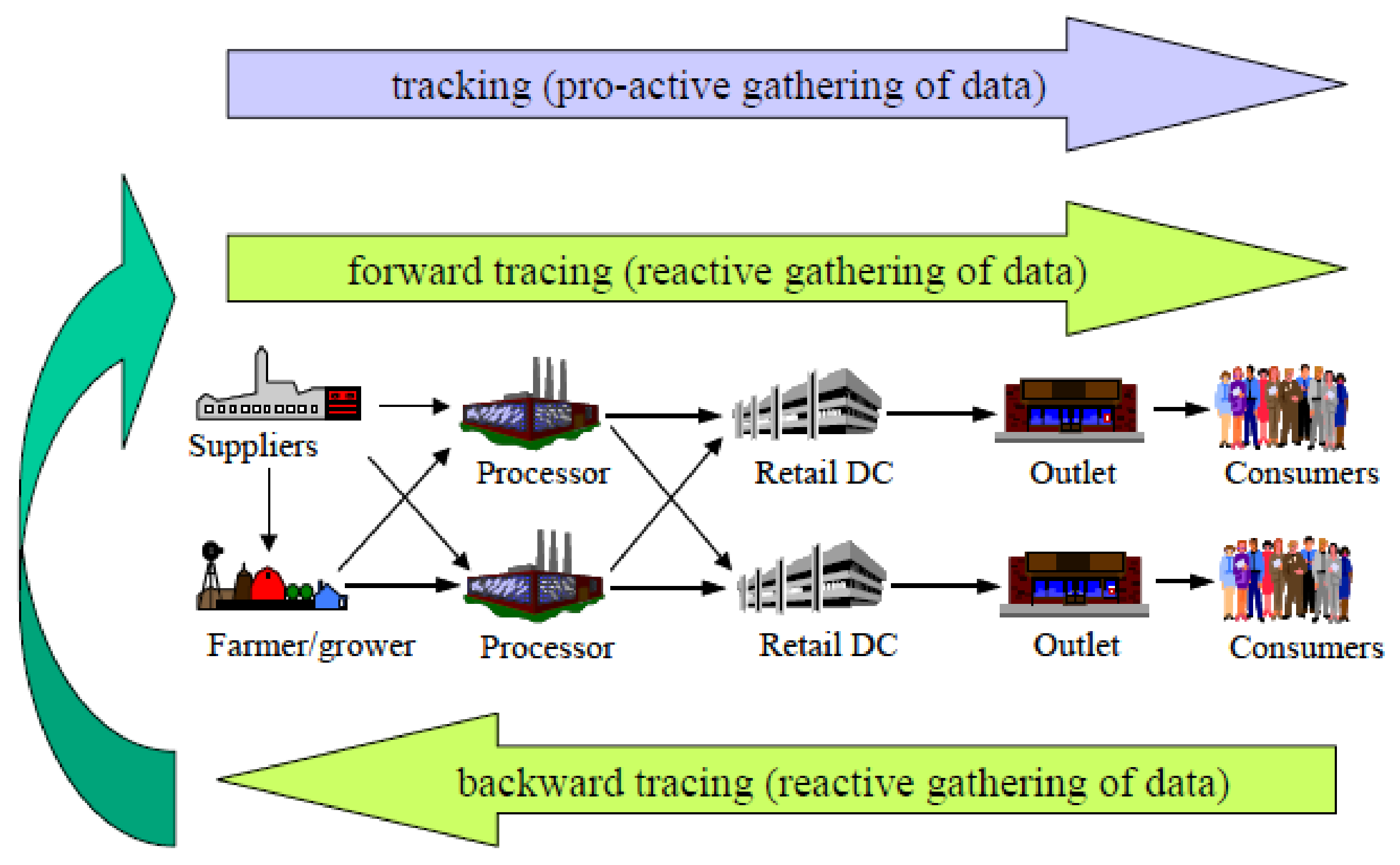
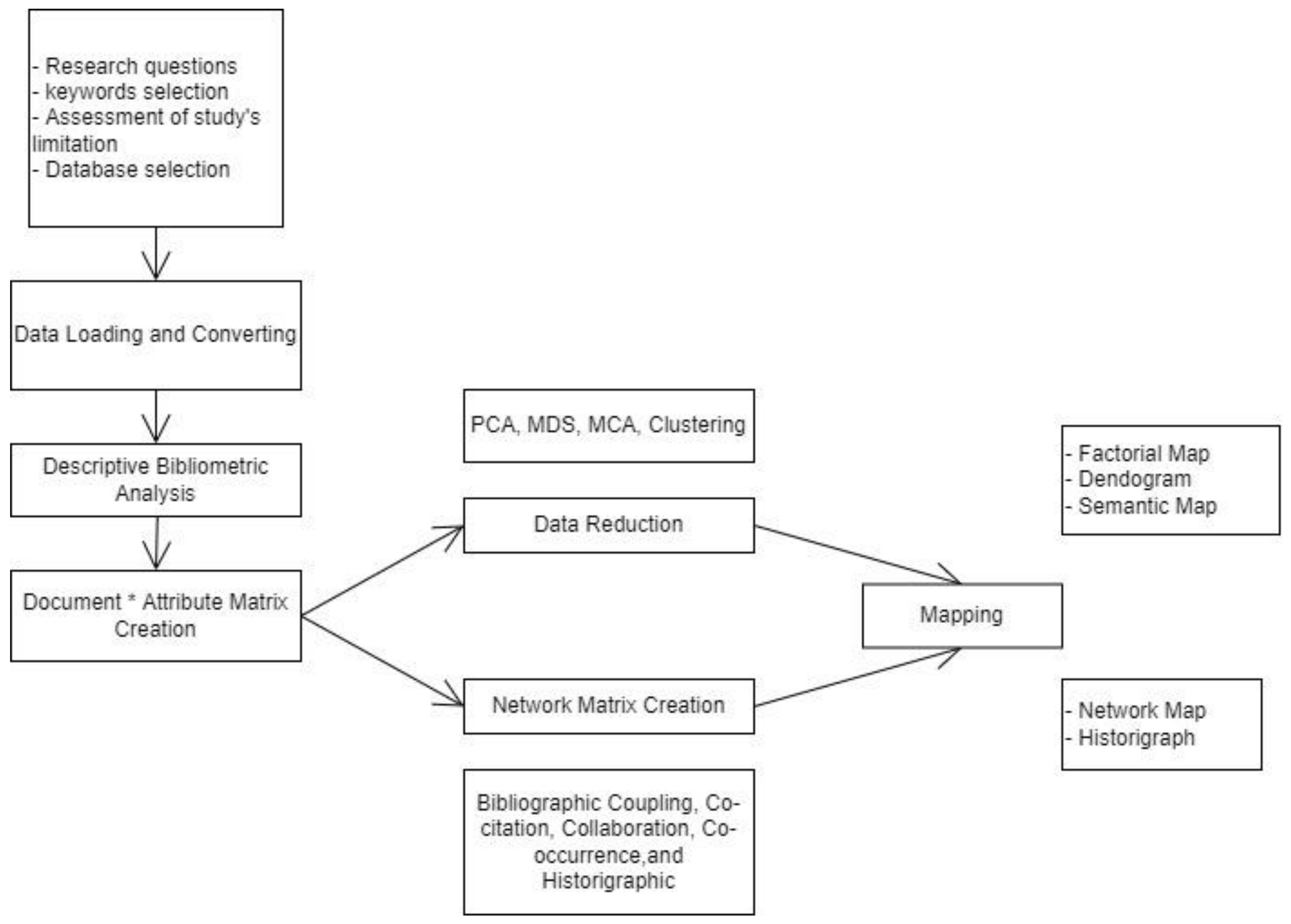
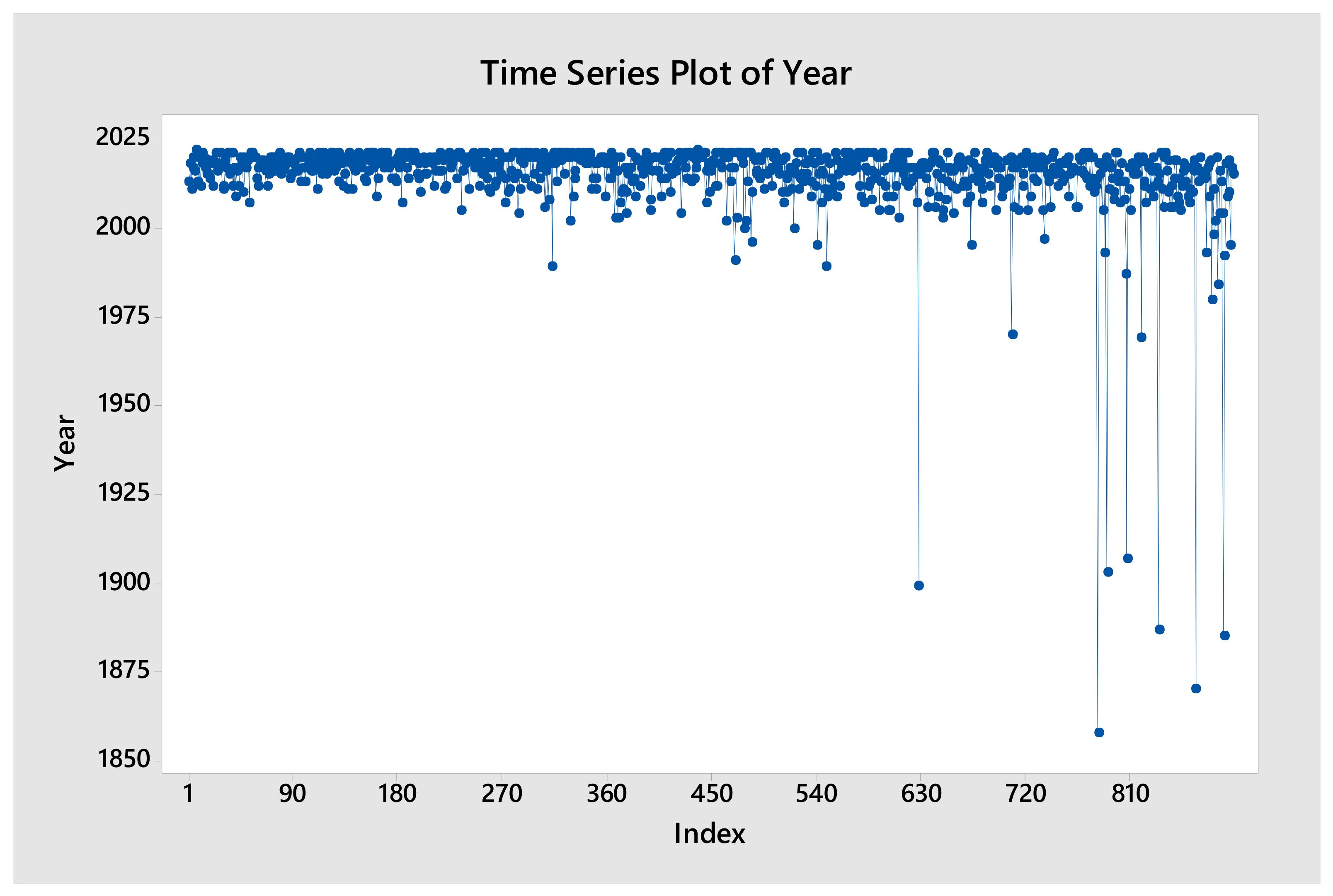
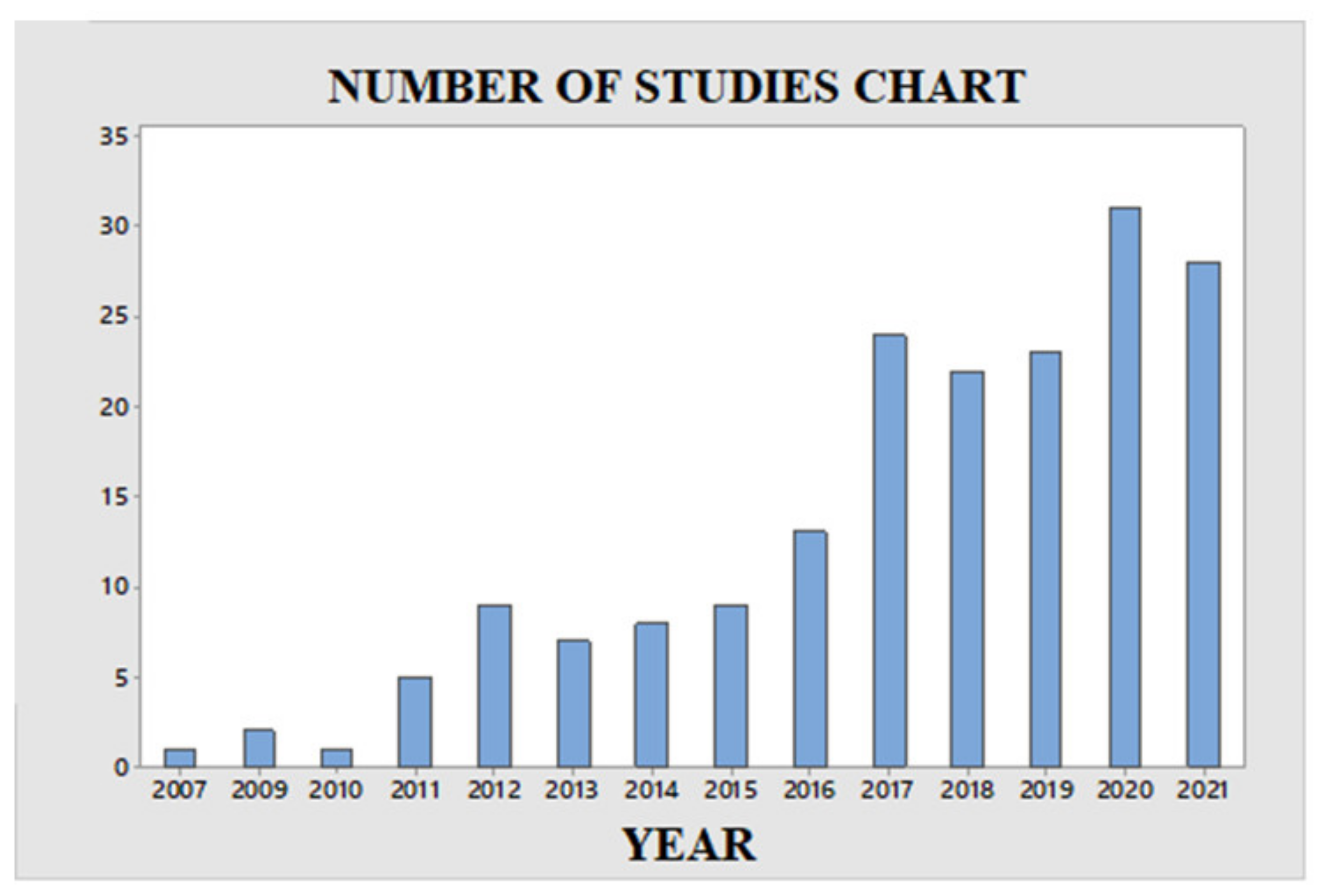
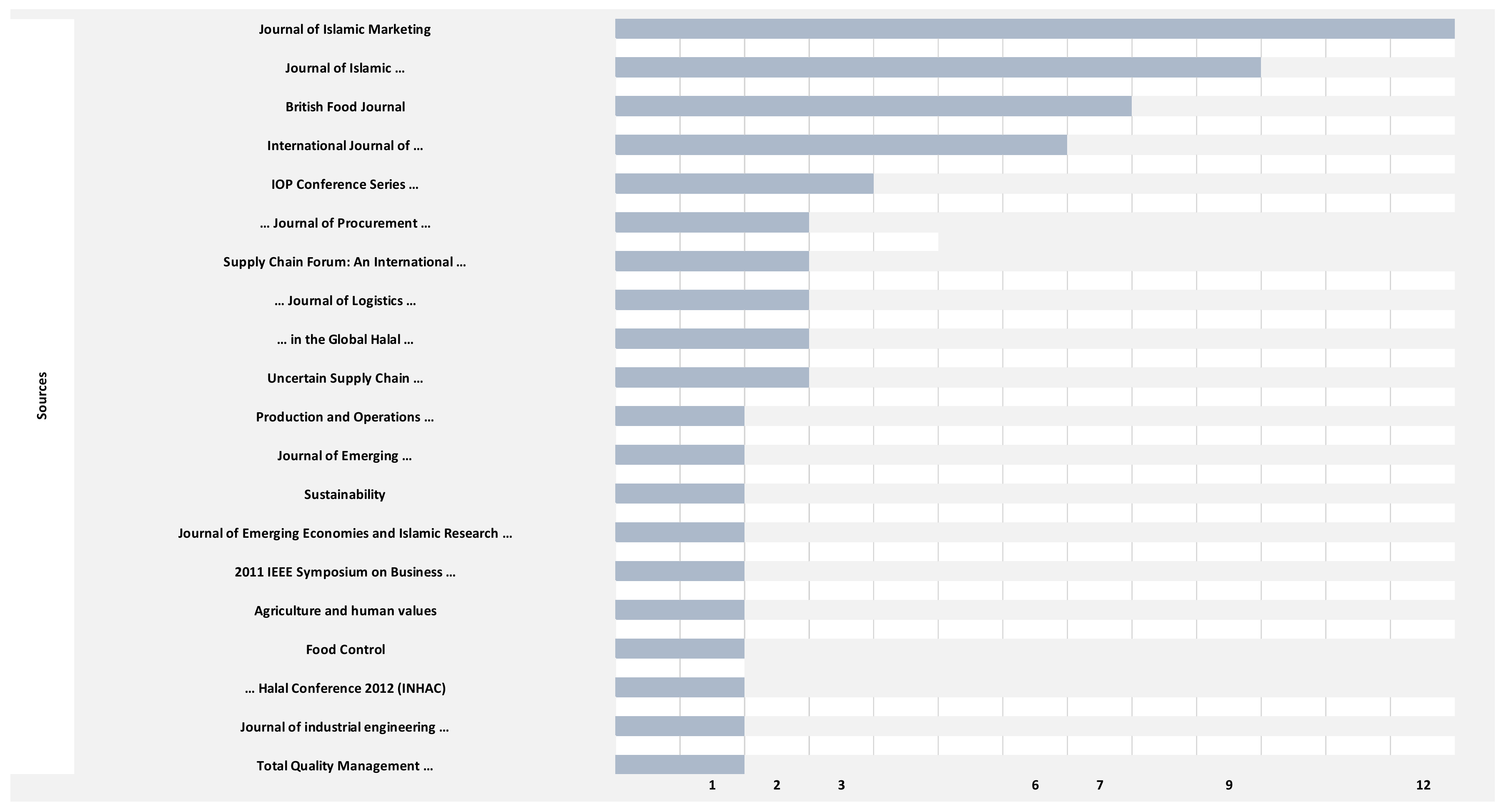
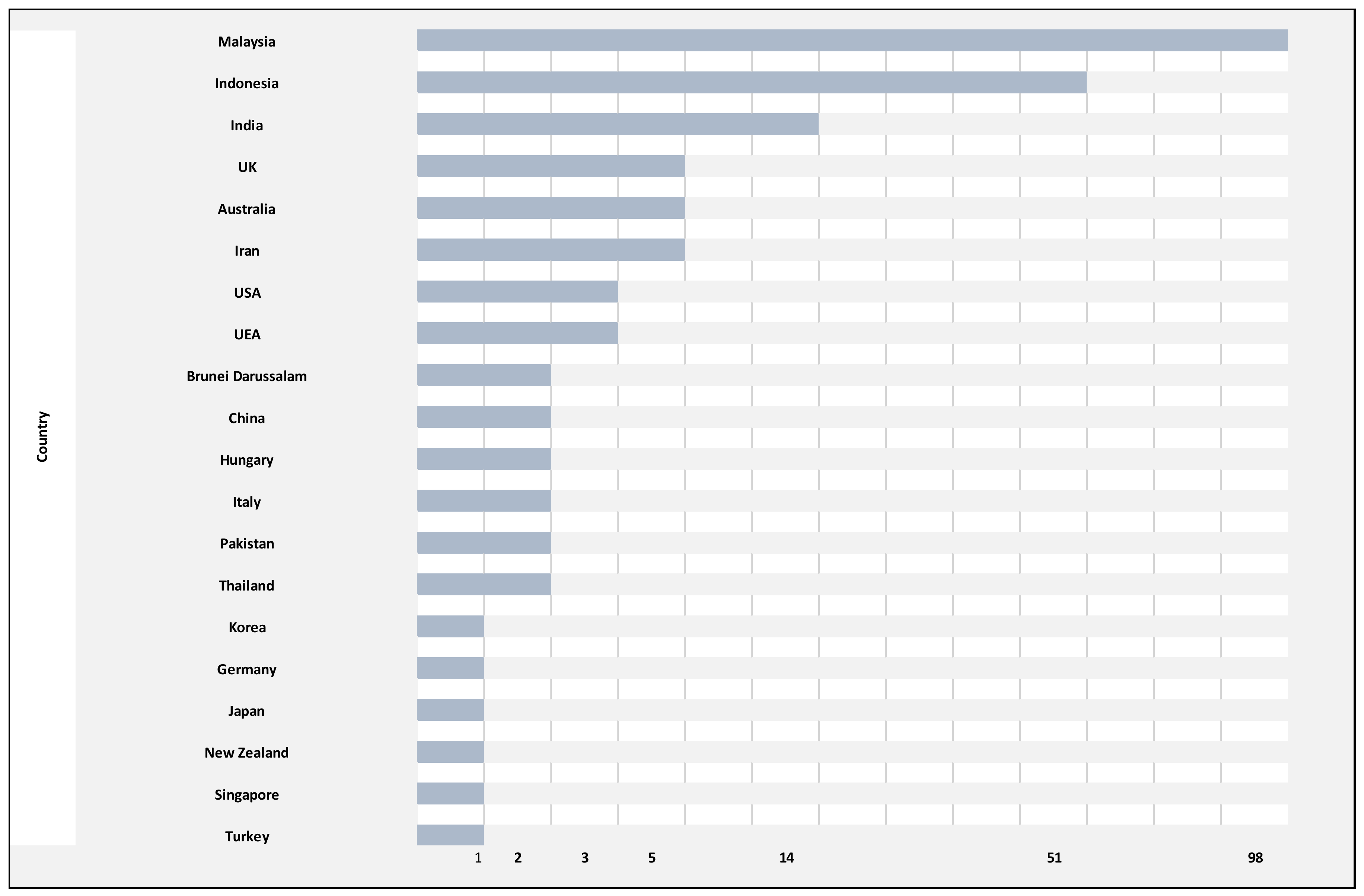
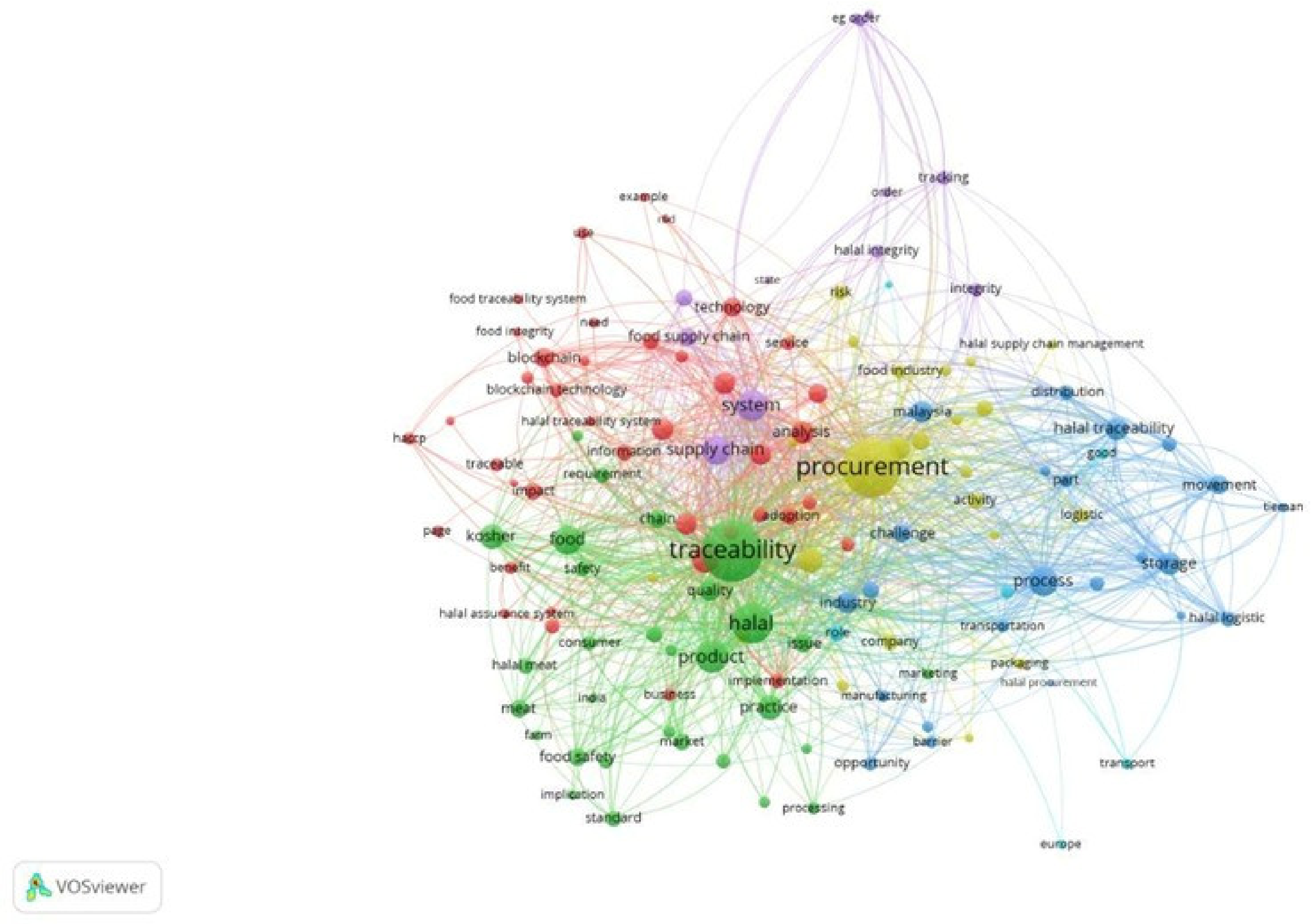
| Ranking | Title | Citations |
|---|---|---|
| 1 | Traceability Issues in Food Supply Chain Management: A Review | 318 |
| 2 | Principles in Halal Supply Chain Management | 295 |
| 3 | Food Waste, Catering Practices, and Public Procurement: A Case Study of Hospital Food Systems in Wales | 187 |
| 4 | Establishing the Principles in Halal Logistics | 165 |
| 5 | Halal Supply Chain Critical Success Factors: A Literature Review | 151 |
| 6 | Halal Supply Chain in the Food Industry - A conceptual model | 151 |
| 7 | Halal Logistics in Malaysia: A SWOT Analysis | 141 |
| 8 | Tracking and Tracing Technology for Halal Product Integrity over the Supply Chain | 129 |
| 9 | Blockchain for Supply Chain Traceability: Business Requirements and Critical Success Factors | 129 |
| 10 | Qualitative Research on Critical Issues in Halal Logistics | 123 |
Publisher’s Note: MDPI stays neutral with regard to jurisdictional claims in published maps and institutional affiliations. |
© 2022 by the authors. Licensee MDPI, Basel, Switzerland. This article is an open access article distributed under the terms and conditions of the Creative Commons Attribution (CC BY) license (https://creativecommons.org/licenses/by/4.0/).
Share and Cite
Masudin, I.; Rahmatullah, B.B.; Agung, M.A.; Dewanti, I.A.; Restuputri, D.P. Traceability System in Halal Procurement: A Bibliometric Review. Logistics 2022, 6, 67. https://doi.org/10.3390/logistics6040067
Masudin I, Rahmatullah BB, Agung MA, Dewanti IA, Restuputri DP. Traceability System in Halal Procurement: A Bibliometric Review. Logistics. 2022; 6(4):67. https://doi.org/10.3390/logistics6040067
Chicago/Turabian StyleMasudin, Ilyas, Bima Bagos Rahmatullah, Muhammad Armand Agung, Inka Amalia Dewanti, and Dian Palupi Restuputri. 2022. "Traceability System in Halal Procurement: A Bibliometric Review" Logistics 6, no. 4: 67. https://doi.org/10.3390/logistics6040067
APA StyleMasudin, I., Rahmatullah, B. B., Agung, M. A., Dewanti, I. A., & Restuputri, D. P. (2022). Traceability System in Halal Procurement: A Bibliometric Review. Logistics, 6(4), 67. https://doi.org/10.3390/logistics6040067






